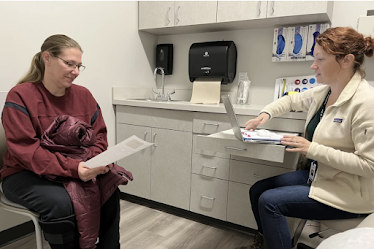 |
| A parched area of rapidly dropping Lake Powell near Lone Rock at Big Water, Utah. (Photo by Joshua Lott, The Washington Post) |
As the levels of Colorado River reservoirs dip drastically low, the arid Southwest may be facing a domino effect of disasters. It could begin with a whirlpool "if the surface of Lake Powell . . . already a quarter of its former size, drops another 38 feet down the concrete face of the 710-foot Glen Canyon Dam here. At that point, the surface would be approaching the tops of eight underwater openings that allow river water to pass through the hydroelectric dam," reports Joshua Partlow of The Washington Post.
"The normally placid Lake Powell, the nation’s second-largest reservoir, could suddenly transform into something resembling a funnel, with water circling the openings," Partlow writes, citing dam operators. "If that happens, the massive turbines that generate electricity for 4.5 million people would have to shut down — after nearly 60 years of use — or risk destruction from air bubbles. Such an outcome — known as a “minimum power pool” — was once unfathomable here. Now, the federal government projects that day could come as soon as July."
Partlow writes, "The Colorado River, which serves roughly one in 10 Americans, is the region’s most important waterway. On the way to such dire outcomes at Lake Powell — which federal officials have begun both planning for and working aggressively to avoid — scientists and dam operators say water temperatures in the Grand Canyon would hit a roller coaster, going frigid overnight and then heating up again, throwing the iconic ecosystem into turmoil."
Tom Buschatzke, director of Arizona’s Department of Water Resources, "has also been raising the alarm about Lake Powell reaching dead pool — an elevation 120 feet below the threshold for producing power," Partlow reports. Buschatzke told him, “It is a possibility. I can’t tell you the probability. But that’s an outcome that would be not only an ecological disaster, but the world would have its attention on such an outcome in a very negative way. . . . you’re not going to have a river. It would be a catastrophe for the entire system.”
In August, the Biden administration called on "the seven states of the Colorado River basin to cut water consumption by 2 to 4 million acre-feet — up to a third of the river’s annual average flow — to protect power generation and avoid such dire outcomes," Partlow reports. "But negotiations have not produced an agreement. And the Interior Department has not yet mandated those cuts, even after an August deadline passed for states to propose voluntary reductions." Maybe an election got in the way.

























